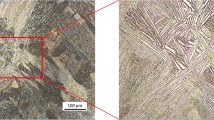Abstract
Creep deformation behaviors in lamellar TiAl alloys have been investigated. As in the case with metals, the normal primary creep stage was observed. As creep strain increased within the primary regime, dislocation density decreased, and creep activation energy increased from 300 kJ/mol, the activation energy of the self-diffusion of Ti in TiAl, to about 380 kJ/mol, that of steady state creep deformation. During primary creep deformation of lamellar TiAl, as the initial dislocation density decreased, the α2 -phase was found to transform to a γ-phase, generating new dislocations which contributed to the creep deformation. In other words, this phase transformation is the source of the dislocation generation for continuous creep deformation. Therefore, we suggest that phase transformation is the rate controlling processes having an activation energy of about 400 kJ/mol, which is higher than that of self-diffusion. A small amount of prestrain was found to be responsible for the reduction of initial dislocation density. In addition, this prestrained specimen showed significantly reduced primary creep strain, and the creep activation energy in the primary stage was measured to be about 380 kJ/mol. These results clearly confirm the suggested creep deformation mechanism of lamellar TiAl alloys.
Similar content being viewed by others
References
Y.-W. Kim and D. M. Dimiduk,J. Metal 43, 40 (1991).
S. W. Nam and H. S. Cho,Proc. of the 9th Conf. on Mechanical Behaviors of Materials (ed., Y. C. Yoo), p. 33, KIMM, Kw-angyang, Korea (1996).
J. Beddoes, L. Zhao, P. Au, D. Dudzinski and J. Triantafillou,Structural Intermetallcs (eds., M. V. Nathal, R. Daralia, C. T. Liu, P. L. Martin, D. V. Miracle, R. Wagner and M. Yamaguchi), p. 109, TMS, Champion, USA (1997).
O. D. Sherby and P. M. Burke,Prog. Mater. Sci 13, 325 (1967).
W. L. Bradley, S. W. Nam and D. M. Matlock,Metall. Trans. A 7, 425 (1976).
M. Yamaguchi and Y Umakoshi,Prog. Mater. Sci. 34, 1 (1990).
W. Sprengel, N. Oikawa, and H. Nakajima,Intermetallics 4, 185 (1996).
H. S. Cho, S. W. Nam, S-K. Hwang and N. J. Kim,Scripta mater. 36, 1295 (1997).
H. S. Cho, S. W. Nam and Y-W. Kim,Metals and Materials 4, 33 (1998).
S. W. Nam, H. S. Cho, S-K. Hwang and N. J. Kim,Mater. Sci. Eng. A 239-240, 457 (1997).
Author information
Authors and Affiliations
Rights and permissions
About this article
Cite this article
Nam, S.W., Cho, H.S., Hwang, SK. et al. Investigation of primary and secondary creep deformation mechanism of TiAl. Metals and Materials 6, 287–292 (2000). https://doi.org/10.1007/BF03028073
Issue Date:
DOI: https://doi.org/10.1007/BF03028073




